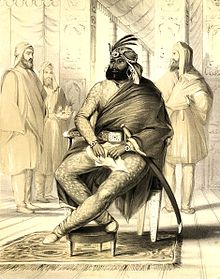Ranjit Singh
Maharajah Ranjit Singh ( Panjabi ਰਣਜੀਤ ਸਿੰਘ ; born November 13, 1780 in Gujranwala , † June 27, 1839 in Lahore ), also known as the "Lion of Punjab", was a member of the Sikhs and the first ruler of the unified Punjab . His grave is in Lahore, Pakistan .
biography
Ranjit Singh was born in Punjab , the son of Sirdar Maha Singh ; his father ruled over an area in western Punjab around Gujranwala . At that time, the Punjab was divided into different areas with separate rulers. At the age of twelve, Ranjit inherited from his father. After several campaigns, including the conquest of Lahore, which he also made his capital, in 1799, he united the various territories to form the Sikh Empire and took the title on April 12, 1801 ( Vaishaki Day) of a Maharaja . In 1802 he captured the holy city of Amritsar . In the following years he waged war against the Pashtuns and expelled them from western Punjab. He conquered the province of Multan (1818) in southern Punjab and took Peshawar in the same year . Other conquests were Jammu , Kashmir (1819) and the mountainous states north of Anandpur , the largest of which was Kangra . In several campaigns to Afghanistan in the 1830s, he and his commanders succeeded in greatly reducing the influence of the mountain tribes on the fertile Punjab. He captured the famous war horse Laili from Sultan Mohammad Shah.
He modernized his army with the help of European mercenaries such as the former Napoleonic general Jean-Francois Allard . The result was a comparatively powerful Sikh empire, which was the only princely state in India that was not controlled by the British . He brought law and order and was famous for his tolerance of other religions and ethnic groups. For example, he abolished the " Jizya " tax for Hindus and Sikh . Ranjit Singh died on June 27, 1839 as a paralyzed man (the exact cause of the paralysis is not known). His eldest son Kharak Singh came into inheritance. As a result, the state quickly fell apart. The army and princes fought for supremacy until the end of the empire in the Second Anglo-Sikh War in 1847, when it was annexed by the British. Duleep Singh , the largely incompetent youngest son of Ranjit, was forced to abdicate. He was the last Maharajah of the Sikh Empire.
meaning
Ranjit is known as the creator of a united and powerful Punjab and as the owner of the Koh-i-Noor diamond. His most beautiful and longest lasting work is the beautification of the Harmandir Sahib in Amritsar, the largest sanctuary of the Sikhs. It is also known as the Golden Temple because of the large amounts of marble and gold that were used for this. The title Sher-e-Punjab (Lion of Punjab) is still today a designation of respect for powerful men.
literature
- Khushwant Singh : Ranjit Singh. Maharaja of the Punjab. Allen & Unwin, London 1962, (later: Penguin Books, New Delhi et al. 2008, ISBN 978-0-14-333060-8 ).
- Ian Heath: The Sikh Army 1799-1849 (= Osprey Military. Men-at-arms Series. 421). Osprey Publishing, Oxford 2005, ISBN 1-84176-777-8 .
- Jean-Marie Lafont: Maharaja Ranjit Singh. Lord of the Five Rivers. Oxford University Press, New York NY et al. 2002, ISBN 0-19-566111-7 .
Web links
Individual evidence
- ^ Two emperors in the same mold . In: Tribune India . Retrieved May 16, 2019.
| personal data | |
|---|---|
| SURNAME | Singh, Ranjit |
| BRIEF DESCRIPTION | Indian ruler, ruler of Punjab |
| DATE OF BIRTH | November 13, 1780 |
| PLACE OF BIRTH | Gujranwala |
| DATE OF DEATH | June 27, 1839 |
| Place of death | Lahore |

